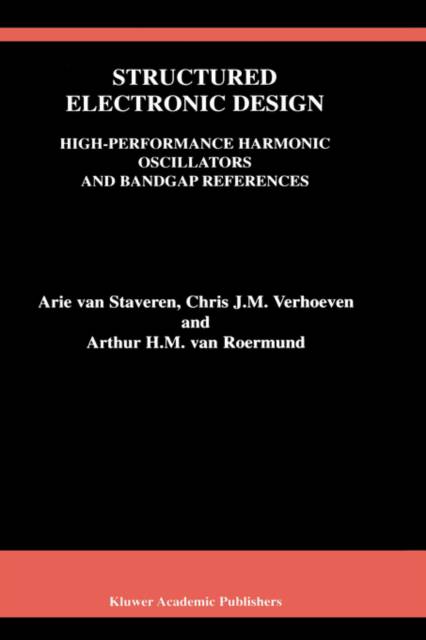
- Retrait gratuit dans votre magasin Club
- 7.000.000 titres dans notre catalogue
- Payer en toute sécurité
- Toujours un magasin près de chez vous
- Retrait gratuit dans votre magasin Club
- 7.000.0000 titres dans notre catalogue
- Payer en toute sécurité
- Toujours un magasin près de chez vous
Structured Electronic Design
High-Performance Harmonic Oscillators and Bandgap References
Arie Van Staveren, Chris J M Verhoeven, Arthur H M van Roermund
251,45 €
+ 502 points
Format
Description
Analog design still has, unfortunately, a flavor of art. Art can be beautiful. However, art in itself is difficult to teach to students and difficult to transfer from experienced analog designers to new trainee designers in companies.
Structured Electronic Design: High-Performance Harmonic Oscillators and Bandgap References aims to systemize analog design. The use of orthogonalization of the design of the fundamental quality aspects (noise, distortion, and bandwidth) and hierarchy in the subsequent design steps, enables designers to achieve high-performance designs, in a relatively short time. As a result of the systematic design procedure, the effect of design decisions on the circuit performance is made clear. Additionally, the use of resources for reaching a specified performance is tracked. This book, therefore, describes the structured electronic design of high-performance harmonic oscillators and bandgap references.
The structured design of harmonic oscillators includes the maximization of the carrier-to- noise ratio by means of tapping, i.e. an impedance adaption method for noise matching. The bandgap reference, a popular implementation of a voltage reference, is studied via the unusual concept of the linear combination of base-emitter voltages. The presented method leads to the design of high-performance references in CMOS and Bipolar technology. Using this concept, on a high level of abstraction the quality with respect to, for instance, noise and power-supply rejection can be identified. In this book, it is shown with several design examples that this method provides an excellent starting point for the design of high-performance bandgap references.
Auxiliary to the harmonic-oscillator and bandgap reference design are the negative- feedback amplifiers. In this book the systematic design of the dynamic behavior is emphasized. By means of the identification of the dominant poles, it is possibleto give an upper limit of the attainable bandwidth, even before the real frequency compensation is accomplished.
Structured Electronic Design: High-Performance Harmonic Oscillators and Bandgap References is a valuable book for researchers and designers, as well as students in the field of analog design. It helps both the experienced and trainee designer to come to grips with the design of analog circuits. The presented method is illustrated by several well- described design examples.
Structured Electronic Design: High-Performance Harmonic Oscillators and Bandgap References aims to systemize analog design. The use of orthogonalization of the design of the fundamental quality aspects (noise, distortion, and bandwidth) and hierarchy in the subsequent design steps, enables designers to achieve high-performance designs, in a relatively short time. As a result of the systematic design procedure, the effect of design decisions on the circuit performance is made clear. Additionally, the use of resources for reaching a specified performance is tracked. This book, therefore, describes the structured electronic design of high-performance harmonic oscillators and bandgap references.
The structured design of harmonic oscillators includes the maximization of the carrier-to- noise ratio by means of tapping, i.e. an impedance adaption method for noise matching. The bandgap reference, a popular implementation of a voltage reference, is studied via the unusual concept of the linear combination of base-emitter voltages. The presented method leads to the design of high-performance references in CMOS and Bipolar technology. Using this concept, on a high level of abstraction the quality with respect to, for instance, noise and power-supply rejection can be identified. In this book, it is shown with several design examples that this method provides an excellent starting point for the design of high-performance bandgap references.
Auxiliary to the harmonic-oscillator and bandgap reference design are the negative- feedback amplifiers. In this book the systematic design of the dynamic behavior is emphasized. By means of the identification of the dominant poles, it is possibleto give an upper limit of the attainable bandwidth, even before the real frequency compensation is accomplished.
Structured Electronic Design: High-Performance Harmonic Oscillators and Bandgap References is a valuable book for researchers and designers, as well as students in the field of analog design. It helps both the experienced and trainee designer to come to grips with the design of analog circuits. The presented method is illustrated by several well- described design examples.
Spécifications
Parties prenantes
- Auteur(s) :
- Editeur:
Contenu
- Nombre de pages :
- 284
- Langue:
- Anglais
- Collection :
- Tome:
- n° 604
Caractéristiques
- EAN:
- 9780792372837
- Date de parution :
- 31-12-00
- Format:
- Livre relié
- Format numérique:
- Genaaid
- Dimensions :
- 156 mm x 234 mm
- Poids :
- 607 g

Les avis
Nous publions uniquement les avis qui respectent les conditions requises. Consultez nos conditions pour les avis.






